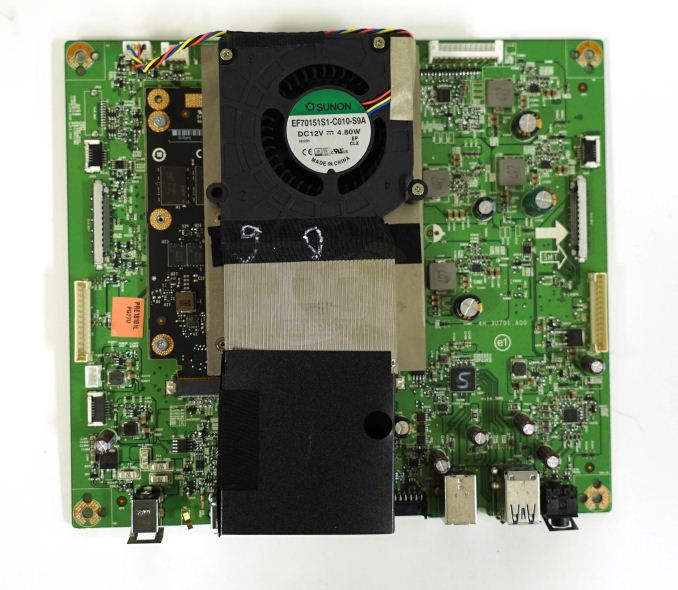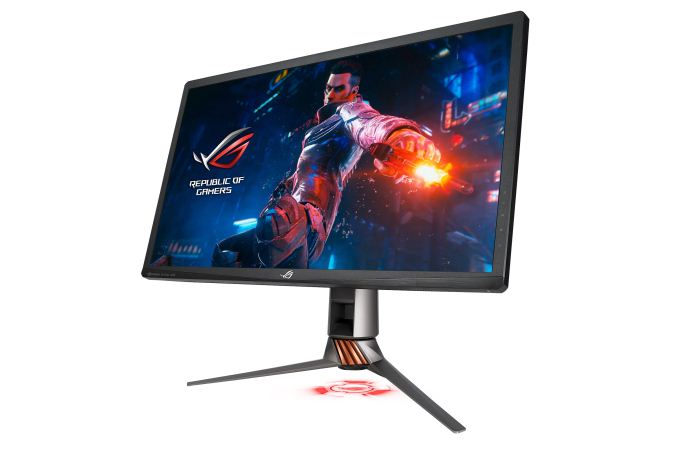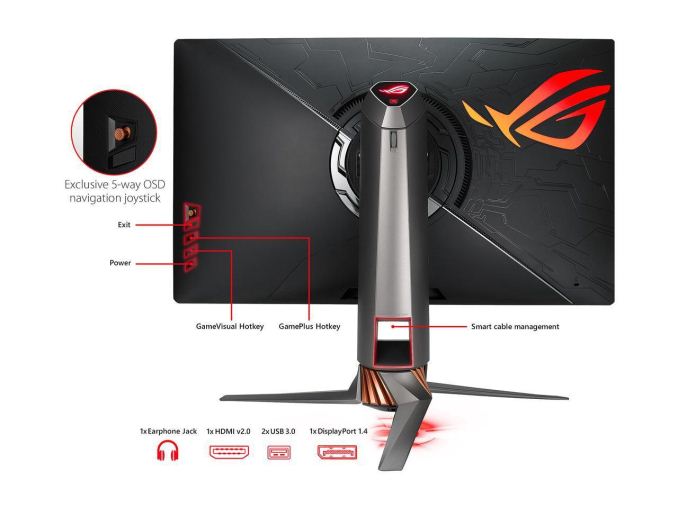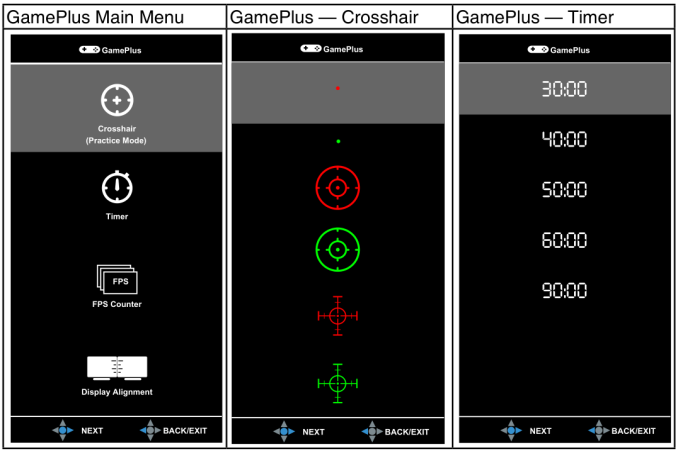The Asus ROG Swift PG27UQ G-SYNC HDR Monitor Review: Gaming With All The Bells and Whistles
by Nate Oh on October 2, 2018 10:00 AM EST- Posted in
- Monitors
- Displays
- Asus
- NVIDIA
- G-Sync
- PG27UQ
- ROG Swift PG27UQ
- G-Sync HDR
Physical Design and Features
Starting with appearances, the design of the PG27UQ is, to put colloquially, quite thick. This would typically be an area where different companies can distinguish between similar products, in this case meaning Asus and Acer, but the dimensions are a consequence of the AUO LCD/backlight unit, the G-Sync HDR module, and HSF assembly.
And yes, a heatsink and fan. Topping the bulkness off is the aforementioned active cooling with the fan, located behind the stand/VESA mount point. The fan's behavior is not really documented, but it runs during standby and sometimes when the monitor is powered off - the latter behavior had me slightly confused on first use, as the fan spun up once I plugged in the monitor. Thankfully, the noise levels are low enough that it should only be a concern for fanless/silent configurations.

PCPerspective's photo of the FPGA module and fan
A teardown by PCPer revealed an Altera Arria 10 GX 480 FPGA with 3GB DDR4-2400 RAM, a substantial upgrade from the Altera Arria V GX FPGA with 768MB DDR3L of the original G-Sync module. NVIDIA stated that, like previous iterations, the module does not replace the TCON and does not support VESA DSC. The latter has been suggested as a solution to the bandwidth limitations of combined high res/high refresh/HDR, and we know that DisplayPort 1.4 includes the DSC standard. Implementing DSC for G-Sync may or may not add latency, but NVIDIA probably explored that option before going with the current implementation of chroma subsampling past 98Hz.
More interestingly, NVIDIA also mentioned that the G-Sync HDR module uses eDP to interface with the LCD panel, as opposed to the first generation’s LVDS, which is an aged standard nowadays. In general, eDP provides higher bandwidth, requiring fewer PCB traces and signal wires overall, and so consumes less power. Except in this case, the overall power usage and/or heat generation requires a blower fan.
It’s been reported that the 27-inch panel will come in a non-HDR variant without the FALD backlight, but the price reduction is harder to guess, since the G-Sync HDR module and quantum dot film would likely still be used. The panel will presumably have an eDP interface, which wouldn’t be compatible with the LVDS-only capability of the first generation G-Sync modules. At the least, there likely wouldn’t be a need for active cooling anymore.
So in contrast with the modern trend of smaller screen borders, the PG27UQ bezels are noticeable at around 15mm at the sides and around 20mm on the top and bottom. The three-point stand is large and the unit as a whole is on the heavier side, just a little over 20 pounds. That stand actually allows for underside LEDs, which can project a logo on the desk below, and the monitor comes with customizable blank plastic covers for this purpose. This falls under the "LIGHT IN MOTION" OSD, and a separate "Aura RGB" option governs LEDs for the ROG logo at the back of the stand. Alternatively, Aura Sync can be enabled to control the "Aura RBG" lighting.
Similarly, the ROG logo can be projected rearwards by the "ROG Light Signal," the last bit in the monitor's bling kit. The power LED also does turn red, but this is to indicate that the monitor is in G-Sync model; it is white during standard operation and amber during standby.
Also at the top of the monitor is an ambient light sensor, which is used with auto-adjusting SDR brightness ('Auto SDR Brightness') and blackness (Auto Black Level) settings in the OSD.
Connectivity is as minimal as it gets without being a big issue: 1 x DisplayPort 1.4, 1 HDMI 2.0 port, an audio jack, and a 2-port USB 3.0 hub. By standards of a premium monitor, it’s certainly not ideal; even if the panel specifications and features are the main attraction over connectivity, the $2000 price point hardly suggests minimal connections. The configuration is identical with Acer's X27 so I'm not sure if there was much Asus could do, unless the reasoning was primarily about margins (if so, then it might indicate that development/panel/module expenses are higher).
The stand and mount combine to offer a good range of adjustment options.
In terms of the on-screen display (OSD), the PG27UQ comes with several SDR picture mode presets called 'GameVisual' as it uses GameVisual Video Intelligence. The modes are as follows:
- Racing (default): intended for input lag reduction
- Scenery: intended for more constrast gradations. Also sets monitor to 100% brightness and locks gamma and Dark Boost (auto gamma curve adjustment)
- Cinema: intended for saturated and cool colors. Also sets monitor to 'Cool' color temperature and locks gamma and Dark Boost
- RTS/RPG: intended to enhance constrast sharpness and color saturation. Also sets gamma to 2.4 and Dark Boost to Level 1
- FPS: intended for higher constrast. Also sets Level 3 Dark Boost
- sRGB: intended for viewing photos and graphics on PCs. Also locks color temperature, brightness, contrast, and gamma
Switching to HDR mode disables GameVisual, and locks gamma, dark boost, variable backlight, and Auto SDR Brightness.
Meanwhile, a separate 'GamePlus' button brings up options for gaming-oriented OSD overlays: crosshair, timer, FPS counter, and screen alignment markers for multi-monitor setup.

















91 Comments
View All Comments
imaheadcase - Tuesday, October 2, 2018 - link
3840x1600 is the dell i mean.Impulses - Tuesday, October 2, 2018 - link
The Acer Predator 32" has a similar panel as that BenQ and adds G-Sync tho still at a max 60Hz, not as well calibrated out of the box (and with a worse stand and controls) but it has dropped in price a couple times to the same as the BenQ... I've been cross shopping them for a while because 2 grand for a display whose features I may or may not be able to leverage in the next 3 years seems dubious.I wanted to go 32" too because the 27" 1440p doesn't seem like enough of a jump from my 24" 1920x1200 (being 16:10 it's nearly as tall as the 16:9 27"erd), and I had three of those which we occasionally used in Eyefinity mode (making a ~40" display). I've looked at 40-43" displays but they're all lacking compared to the smaller stuff (newer ones are all VA too, mostly Phillips and one Dell).
I use my PC for photo editing as much as PC gaming but I'm not a pro so a decent IPS screen that I can calibrate reasonably well would satisfy my photo needs.
Fallen Kell - Tuesday, October 2, 2018 - link
It is "almost" perfect. It is missing one of the most important things, HDMI 2.1, which has the bandwidth to actually feed the panel with what it is capable of doing (i.e. 4k HDR 4:4:4 120Hz). But we don't have that because this monitor was actually designed 3 years ago and only now finally coming to market, 6 months after HDMI 2.1 was released.lilkwarrior - Monday, October 8, 2018 - link
HDMI 2.1 certification is still not done; it would not have been able to call itself a HDMI 2.1 till probably late this year or next year.imaheadcase - Tuesday, October 2, 2018 - link
The 35 inch one has been canceled fyi. Asus rep told me when inquired about it just a week ago, unless in a week something has changed. Reason being panel is not perfect yet to mass produce.That said, its not a big loss, even if disappointing. Because HDR is silly tech so you can skip this generation
EAlbaek - Tuesday, October 2, 2018 - link
I bought one of these, just as they came out. Amazing display performance, but the in-built fan to cool the G-Sync HDR-module killed it for me.It's one of those noisy 40mm fans, which were otherwise banned from PC setups over a decade ago. It made more noise than the entirety of the rest of my 1080 Ti-SLI system combined. Like a wasp was loose in my room all the time. Completely unbearable to listen to.
I tried to return the monitor as RMA, as I thought that couldn't be right. But it could, said the retailer. At which point I chose to simply return the unit.
In my case, these things will have to wait, till nVidia makes a new G-Sync HDR module, which doesn't require active cooling. Plain and simple. I'm sort of guessing that'll fall in line with the availability of micro-LED displays. Which will hopefully also be much cheaper, than the ridiculously expensive FALD-panels in these monitors.
imaheadcase - Tuesday, October 2, 2018 - link
Can't you just replace the fan yourself? I read around the time of release someone simply removed fan and put own silent version on it.EAlbaek - Tuesday, October 2, 2018 - link
No idea - I shouldn't have to void the warranty on my $2000 monitor, to replace a 40mm fan.madwolfa - Tuesday, October 2, 2018 - link
Is that G-Sync HDR that requires active cooling or FALD array?EAlbaek - Tuesday, October 2, 2018 - link
It's the G-Sync HDR chip, apparantly.